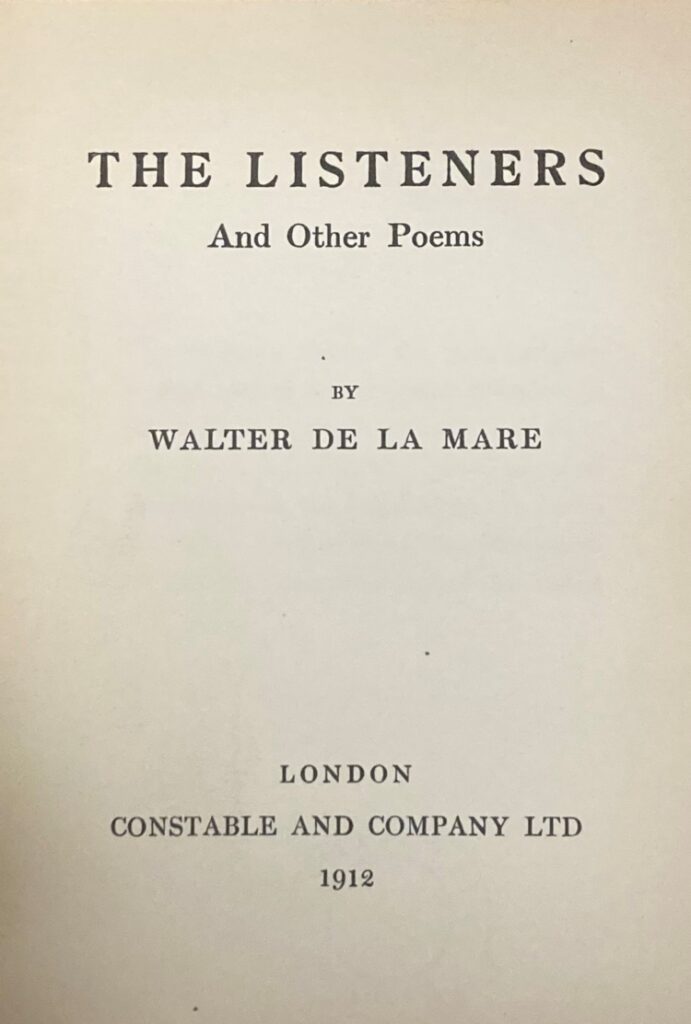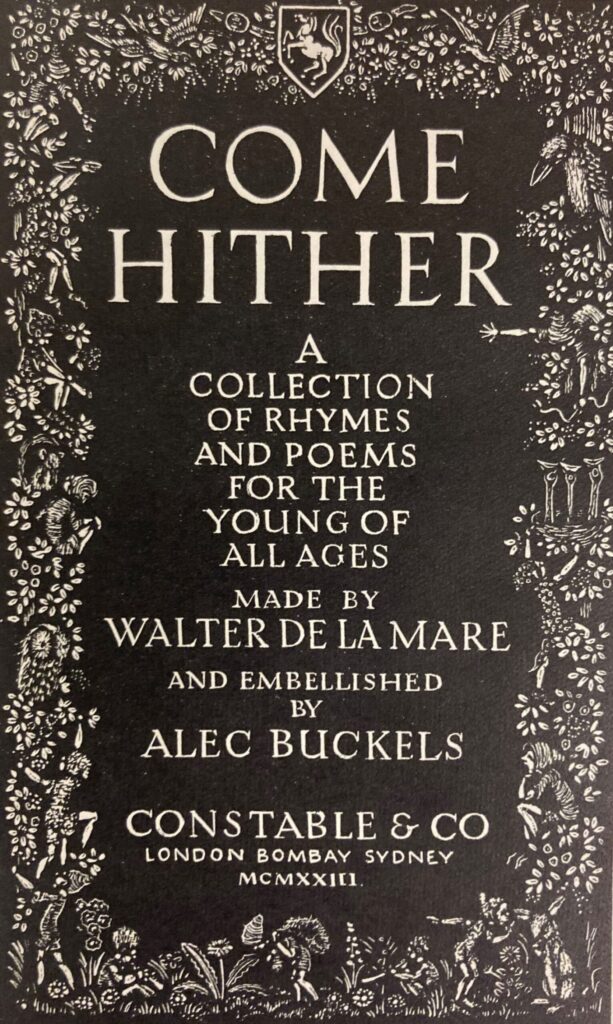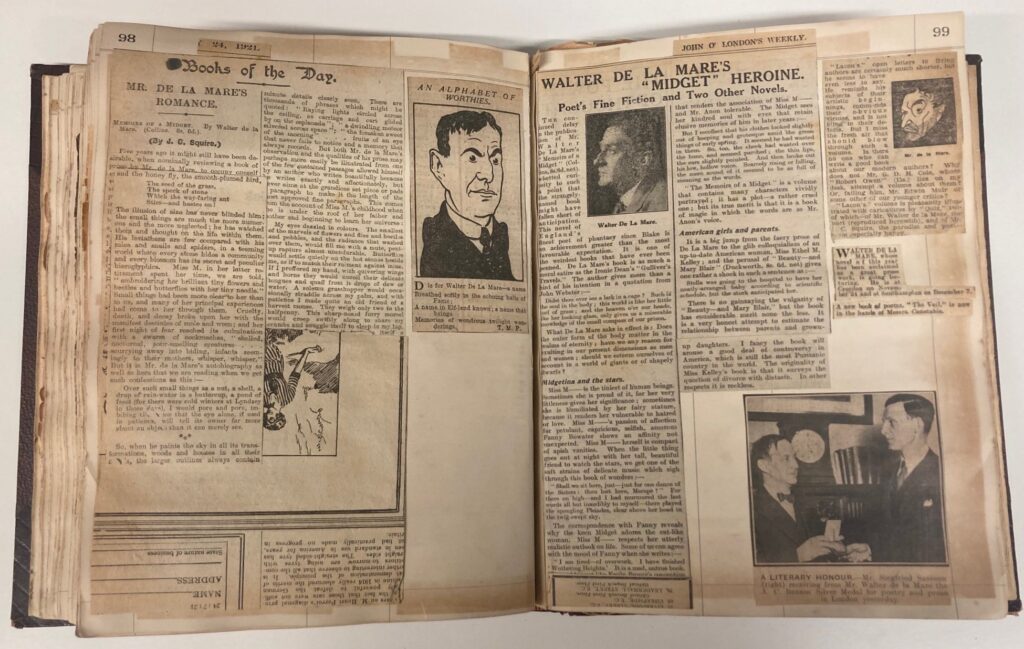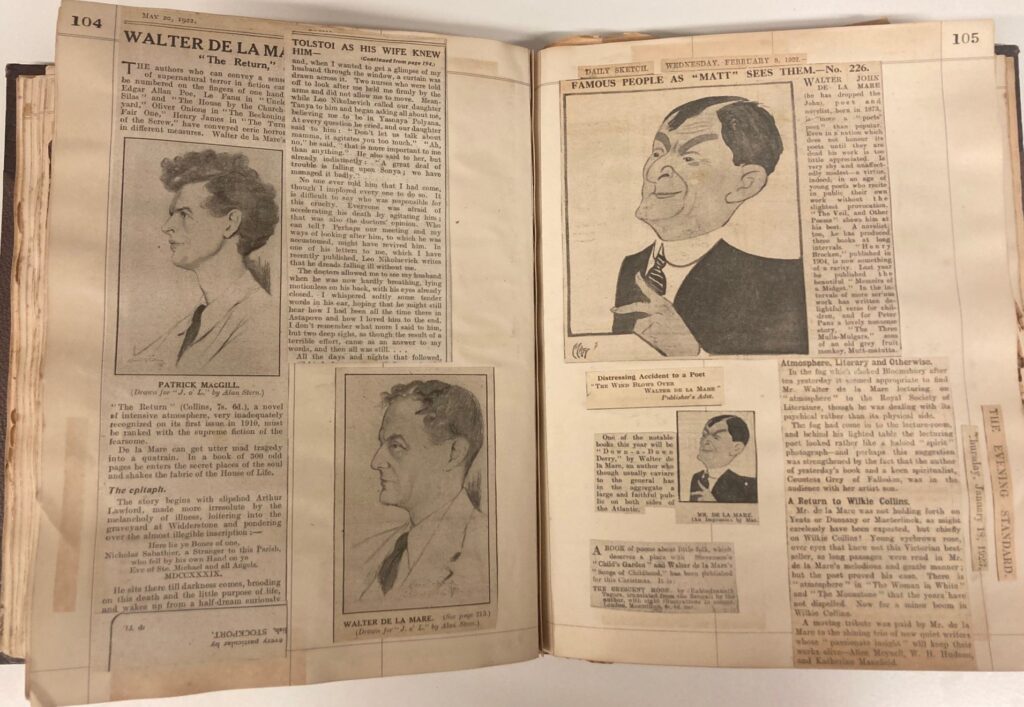The English writer Walter de la Mare was born 150 years ago this week on 25 April 1873. To mark his anniversary, we are publishing a blog by Ash Mowat, a volunteer in the Civic Engagement Team, which also marks the centenary of Come Hither, de la Mare’s much loved anthology of verse for ‘the young of all ages’. The blog also contains details of Edinburgh University Library’s extensive collection of de la Mare correspondence.
Biography
Walter De La Mare (1873-1956) was a London-born writer of poetry and fiction, who was especially renowned and revered for his works created for children. He believed that children’s enhanced capacity for tales of imagination make them a rich audience for vivid, immersive tales of wonder.
After studying at St Paul’s Cathedral School, he was employed for almost twenty years in office work unrelated to his later creative career. Some early inspirations for his own writing were found in his appreciation of the works of Edgar Allan Poe, Thomas Hardy, Henry James, and the Brothers Grimm. A fellow poet Sir Henry Newbolt subsequently enabled De La Mare to focus on his writing by securing him a Civil List pension.
De la Mare’s first major critical success came with the publication of his poetry collection The Listeners in 1912 when he was nearly forty. The title poem of this collection is to me a fine example of his interest in the subject and themes of the eerie, the unknown, and the supernatural. It is both intriguing and ambiguous and is open to an array of interpretations.
In it, we have an unnamed traveller on horseback, calling at an isolated house under moonlight and repeatedly calling out and knocking on the door to be admitted. The ‘phantom’ spirits that occupy the house do not respond or allow the traveller entry. Instead they remain ‘listening in the quiet of the moonlight | To that voice from the world of men’. The listeners are clearly a supernatural force, but the nature of their being and of the traveller’s visit is left unclear, permitting readers and their imaginations to form their own views of the poem’s meaning. The traveller’s final statement ‘Tell them I came, and no one answered | That I kept my word’ to me seemingly alludes to a form of sinister agreement or pact between the traveller and the spirits within, or their masters. It brilliantly captures the unsettling, sinister location and events, and vividly describes the ghoulish, unworldly ambience of the dead-of-night encounter.
- Title-page of ‘The Listeners’ (SC 9303)
- Title-page of ‘Come Hither’ (RB.S.4346)
Come Hither
In 1923, Come Hither was published, the first of several anthologies of poetry for children that de la Mare compiled. Creating such an extensive anthology as Come Hither would have been a major undertaking and a generous one given that it celebrates the work of other writers. In addition to the poems themselves, which range from Chaucer to de la Mare’s contemporaries, there are extensive annotations from de La Mare on the works selected.
In the introduction (‘The Story of this Book), de la Mare tells a fictional tale of childhood. He recounts how a young boy Simon, solitary and wandering, is both unsettled and captivated by an isolated house named Thrae (an anagram of ‘Earth’) and by its mysterious and unnerving occupants. He gradually gets to know Miss Taroone, the imposing lady of the house, who lets him explore Thrae. Simon is full of wonder at its contents, particularly the room of Nahum Tarune (anagram of ‘human nature’), a veritable cabinet of curiosities filled with stuffed animals, strange tools, art, and curious artefacts of all kinds. Miss Taroone explains that Nahum is a relative, an adventurous travelling man who is absent on his latest journey. Simon is shown a book called The Other Worlde, a collection of favourite poems and stories compiled by Nahum as a boy. Simon gets to read and explore the book and to copy the poems out into a collection of his own.
In this foreword De La Mare is introducing the anthology’s themes of escape, wonder, the blurring of reality and visions: ‘When I was most busy and happy and engrossed in it, it seemed to be a house which might at any moment vanish before your eyes, showing itself to be but the outer shell or hiding place of an abode still more enchanting.’
Simon explores not just with copying out the poems in the book but with attempts to rewrite some of them. This fictional account of Simon and his discovery of the collection of writings is a suitably poetic and immersive way to conjure our imaginations ahead of the anthology of poems to follow, a kind of intertextuality with the poetic form featured in the introduction’s fictional tale.
Walter de la Mare Papers at Edinburgh University Library
(compiled by Paul Barnaby, Modern Literary Collections Curator)
Edinburgh University Library holds one of the world’s largest collections of Walter de la Mare correspondence. This may seem surprising given the writer’s lack of obvious links to Edinburgh or to Scotland, but the collection originates in a close friendship that de la Mare formed with the retired Edinburgh University Librarian Frank Carr Nicholson (1875-1962). Coll-193 contains 91 letters from de la Mare to Nicholson and to the Scottish born Canadian writer Jessie Georgina Sime (1868-1958), with whom Nicholson collaborated on a number of novels. These letters were donated to Edinburgh University Library by Nicholson’s widow Mary in 1963. Edinburgh University Library subsequently purchased ca. 200 further letters by de la Mare to various correspondents, now held in 10 folders as part of Coll-193. There is particularly substantial correspondence with the novelist Gerald Bullett (1893-1958) (66 letters) and with the publisher J. M. Dent (40 letters).
Further de la Mare acquisitions are held in Coll-1836. These include 14 letters to the English art director and architect Terence Verity and to his wife and professional partner Enid Verity (née Hill) dating from 1944 to 1956 (Coll-1836/1). There are also 3 letters from Walter de la Mare to his secretary Marie Lamigeon (Coll-1836/2).
The Papers of Professor William Fraser Mitchell (Coll-86), an Edinburgh graduate who went on to become Professor of Education at Selly Oak Colleges, Birmingham, also contain two letters sent by Walter de la Mare in 1925. They are in response to an invitation from Mitchell to address the Essay Club of Exeter College, Oxford University, where Mitchell was studying for a BLitt in 17th-century English pulpit oratory. There are also individual letters to John Atkins, Nancy Bowden, and a Mr Wood in the miscellaneous Coll-1848.
A very recent acquisition is a scrapbook album of news-cuttings compiled by the writer’s sister-in-law Violet de la Mare (Coll-1834). It contains numerous articles on or by Walter de la Mare, along with many other press clippings relating to his family. At the back of the scrapbook are two unpublished poems by Walter to his nephew James Roy Delamare.
- From Violet de la Mare’s scrapbook of news cuttings (Coll-1834)
Bibliography



